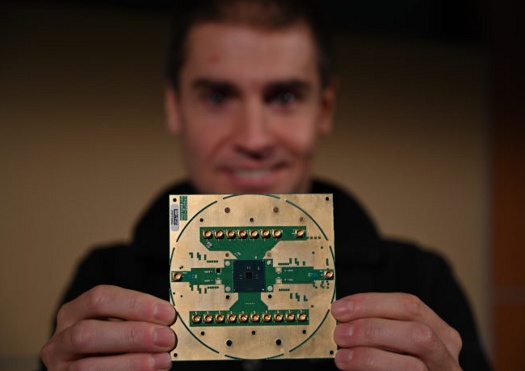 |
| December 24, 2019 | Volume 15 Issue 49 |
Designfax weekly eMagazine
Archives
Partners
Manufacturing Center
Product Spotlight
Modern Applications News
Metalworking Ideas For
Today's Job Shops
Tooling and Production
Strategies for large
metalworking plants
Intel introduces first control chip to enable commercially viable quantum computers

Stefano Pellerano, principal engineer at Intel Labs, holds Horse Ridge, a new cryogenic control chip that aims to speed development of full-stack quantum computing systems. [Credit: Walden Kirsch/Intel Corp.]
On Dec. 9, Intel Labs unveiled a first-of-its-kind cryogenic control chip (code-named "Horse Ridge") that should speed up development of full-stack quantum computing systems. Horse Ridge will enable control of multiple quantum bits (qubits) and set a clear path toward scaling larger systems -- a major milestone on the path to quantum practicality.
Quantum computers promise the potential to tackle problems that conventional computers can't handle by leveraging a phenomena of quantum physics that allows qubits to exist in multiple states simultaneously. As a result, qubits can conduct a large number of calculations at the same time -- dramatically speeding up complex problem-solving.
Developed together with Intel's research collaborators at QuTech, a partnership between TU Delft and TNO (Netherlands Organization for Applied Scientific Research), Horse Ridge is fabricated using Intel's 22-nm FinFET Low Power (22-FFL) technology. In-house fabrication of these control chips at Intel aims to accelerate the company's ability to design, test, and optimize a commercially viable quantum computer.
In the race to realize the power and potential of quantum computers, researchers have focused extensively on qubit fabrication, building test chips that demonstrate the exponential power of a small number of qubits operating in superposition. However, in early quantum hardware developments -- including design, testing, and characterization of Intel's silicon spin qubit and superconducting qubit systems -- Intel identified a major bottleneck toward realizing commercial-scale quantum computing: a lack of development of interconnects and control electronics.
With Horse Ridge, Intel introduces a solution that will enable the company to control multiple qubits and set a clear path toward scaling future systems to larger qubit counts, which is a major milestone on the path to full-blown quantum computing.
"While there has been a lot of emphasis on the qubits themselves, the ability to control many qubits at the same time had been a challenge for the industry," said Jim Clarke, Intel's director of Quantum Hardware. "Intel recognized that quantum controls were an essential piece of the puzzle we needed to solve in order to develop a large-scale commercial quantum system. That's why we are investing in quantum error correction and controls. With Horse Ridge, Intel has developed a scalable control system that will allow us to significantly speed up testing and realize the potential of quantum computing."
VIDEO: How quantum computing will answer unsolved problems.
[Credit: Intel]
But the quantum research community is still at mile one of a marathon toward demonstrating quantum practicality, a benchmark against which the quantum research community can determine whether a quantum system can deliver game-changing performance to solve real-world problems. Intelīs investment in quantum computing covers the full hardware and software stack in pursuit of the development and commercialization of a practical, commercially viable quantum system.
Horse Ridge is a highly integrated, mixed-signal system on a chip (SoC) that brings the qubit controls into the quantum refrigerator -- as close as possible to the qubits themselves. It effectively reduces the complexity of quantum control engineering from hundreds of cables running into and out of a refrigerator to a single, unified package operating near the quantum device.
Designed to act as a radio frequency (RF) processor to control the qubits operating in the refrigerator, Horse Ridge is programmed with instructions that correspond to basic qubit operations. It translates those instructions into electromagnetic microwave pulses that can manipulate the state of the qubits.
Named for one of the coldest regions in Oregon, the Horse Ridge control chip was designed to operate at cryogenic temperatures -- approximately 4 Kelvin. To put this in context, 4 Kelvin is only warmer than absolute zero -- a temperature so cold that atoms nearly stop moving.
This feat is particularly exciting as Intel progresses its research into silicon spin qubits, which have the potential to operate at slightly higher temperatures than current quantum systems require.
Source: Intel
Published December 2019
Rate this article
View our terms of use and privacy policy
